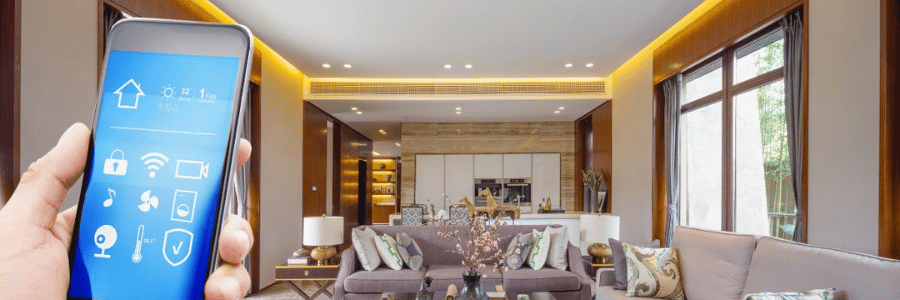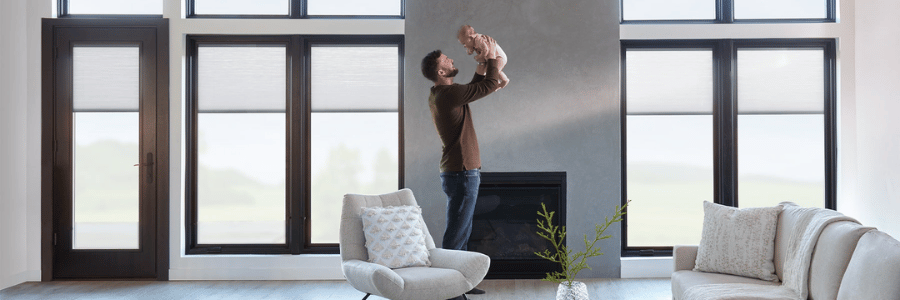Windows have long been an essential part of every home, serving as the link between indoor and outdoor spaces, providing light, ventilation, and views. But what if windows could do more than just open and close? Enter the world of smart windows—an exciting innovation that’s transforming the way we interact with our living spaces. From self-tinting glass to solar-powered features and windows that can be controlled remotely, these technological advancements are not just about looks—they’re about making your home more comfortable, energy-efficient, and convenient. Let’s take a closer look at how these cutting-edge windows are shaping the future of home design and comfort.

What Are Smart Windows?
Smart windows, sometimes called “intelligent windows” or “dynamic glass,” refer to windows that use technology to alter their properties in response to environmental factors or user commands. These windows are designed to do more than just provide light and views—they can change their tint, regulate temperature, and even improve energy efficiency. Smart windows integrate with home automation systems, offering a level of convenience and control that traditional windows simply can’t match.
1. Self-Tinting Windows: Dynamic Light Control
One of the most revolutionary features of smart windows is their ability to change their tint automatically, adjusting to the level of sunlight or heat they’re exposed to. These windows, often referred to as electrochromic windows or smart glass, can darken when the sun is shining directly on them and lighten when it’s cloudy or at night.
How Do They Work?
Self-tinting windows use an electrical current to alter the chemical properties of the glass, causing it to change color. When activated, the windows block a significant amount of ultraviolet (UV) and infrared (IR) light, reducing heat buildup inside your home and minimizing glare. This is particularly useful in sun-drenched rooms where sunlight can make spaces uncomfortable and even fade furniture or flooring over time.
Benefits of Self-Tinting Windows:
- Improved Comfort: Self-tinting windows keep your home cooler in the summer by blocking heat while still allowing natural light to enter.
- Energy Savings: By reducing the need for air conditioning and blinds, these windows can lower cooling costs and reduce energy consumption.
- UV Protection: These windows block harmful UV rays, protecting your furniture, carpets, and artwork from fading over time.

2. Solar-Powered Windows: Harnessing the Sun for Efficiency
As the world turns toward sustainable living, solar-powered windows are gaining traction. These windows integrate photovoltaic (PV) technology, allowing them to generate electricity from sunlight. The energy captured can be used to power the window’s smart features or even contribute to your home’s overall energy grid.
How Do Solar-Powered Windows Work?
Solar-powered windows often combine solar panels with traditional window glass or feature transparent solar cells that blend seamlessly with the glass. When sunlight hits the solar cells, they convert it into electricity. This energy can be used to power window mechanisms like tinting systems or integrated sensors that adjust the window based on temperature, light, or time of day.
Benefits of Solar-Powered Windows:
- Energy Efficiency: Solar-powered windows can reduce your reliance on external energy sources, helping to lower electricity bills and reduce your environmental footprint.
- Sustainable Design: Incorporating solar energy into your windows is a step toward creating a more sustainable home, especially in areas with abundant sunlight.
- Energy Independence: By generating electricity directly from sunlight, solar-powered windows can provide energy for other smart home devices, making your home more self-sufficient.
3. Remotely Controlled Windows: Convenience at Your Fingertips
Gone are the days of manually opening and closing windows or adjusting blinds. With the advent of smart home technology, windows can now be controlled remotely via smartphone apps or integrated with home automation systems like Amazon Alexa, Google Home, or Apple HomeKit.
How Do Remotely Controlled Windows Work?
These windows use motorized systems that can be controlled through a smartphone, tablet, or voice commands. Some systems even include automated sensors that detect environmental changes, such as temperature or humidity, and adjust the window accordingly. For instance, windows can be set to automatically open when the room temperature rises above a certain level, allowing fresh air to circulate.
Benefits of Remotely Controlled Windows:
- Convenience: Open or close your windows from anywhere, whether you’re at home or away, without having to physically be near them.
- Enhanced Ventilation: Use the remote controls to optimize airflow, ensuring your home stays comfortable without having to rely solely on air conditioning or heating.
- Integration with Smart Homes: These windows can be integrated into your overall smart home system, syncing with other devices to create a more efficient and comfortable living environment.

4. Insulating and Soundproof Windows: Better Comfort and Quiet Spaces
Some smart windows go beyond basic functionality to focus on comfort, offering features like enhanced insulation and soundproofing. These windows automatically adjust their properties to optimize your home’s internal environment, keeping noise out and temperature levels stable.
How Do Insulating Windows Work?
Smart insulating windows can use multiple layers of glass, gas fills, or dynamic coatings to adapt to changing temperatures. For example, they can switch between high- and low-thermal conductivity based on outdoor conditions, improving insulation in colder weather and allowing for more heat to enter when the temperature drops.
Benefits of Insulating and Soundproof Windows:
- Better Temperature Control: These windows help to maintain a more stable indoor temperature, improving overall comfort in your home and reducing energy consumption.
- Noise Reduction: Smart windows with soundproofing capabilities help create quieter living spaces, ideal for urban environments or homes near busy streets.
- Year-Round Comfort: Whether it’s winter or summer, insulating windows keep your home comfortable while helping to minimize energy costs.

5. Privacy Windows: Control Your Space
In addition to all the energy-efficient and comfort-enhancing features, smart windows can also help you maintain privacy. Some modern smart windows come with the ability to switch between transparent and opaque states with the push of a button.
How Do Privacy Windows Work?
These windows use switchable glass technology, which allows the window to go from clear to frosted or opaque when activated. This can be particularly useful for bathrooms, home offices, or any space where you want privacy without sacrificing natural light.
Benefits of Privacy Windows:
- On-Demand Privacy: Instantly adjust your window’s opacity for privacy whenever you need it.
- Enhanced Aesthetics: Privacy windows offer a sleek, modern look while maintaining functionality.
- Light Control: These windows allow you to manage both light and privacy with ease, making them perfect for spaces where light control is key.

Conclusion: The Future of Windows is Smart
Smart windows are no longer just a futuristic concept—they’re here, and they’re transforming the way we think about home design, energy efficiency, and convenience. Whether you’re looking to improve your home’s insulation, reduce your carbon footprint, or enhance comfort, smart windows offer a host of benefits that go far beyond traditional windows.
As these technologies continue to evolve, we can expect even more innovations that make our homes smarter, more energy-efficient, and more comfortable. If you’re considering upgrading your windows, now is the perfect time to explore the possibilities of smart windows and take your home to the next level of convenience and sustainability.


